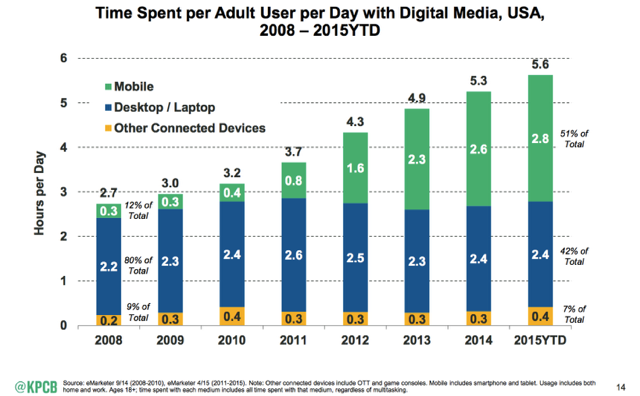If you live in the digital marketing world, you probably know about Mary Meeker’s annual thought bomb, “Internet Trends Report,” even if you don’t have time to read through it. The 2015 edition, published just weeks ago, consists of approximately 200 data-packed slides covering marketing and consumer behavior trends ranging from the growing clout of millennials to emerging advertising formats in China. I strongly advise anyone in local search to read it.
On the surface, 2015 Internet Trends is not about local search. But if you take a close look and read between the lines, Meeker’s report makes some important observations about local search:
Optimizing for Mobile is Table Stakes
The numbers are staggering: according to Mary Meeker, in 1995 there were 80m mobile phone users around the world, representing 1 percent of the world’s population. Today there are 5.2bn mobile phone users, or 73 percent of the population. Meanwhile, according to Google, mobile searches have officially overtaken desktop search.
Now, connect the dots: if your local search strategy fails to address the mobile consumer, you might as well not have a local search strategy. The time is long past for marketers to consider mobile as the future of search. Mobile is the here and now of search. As Meeker reports (with considerable understatement), “mobile remains compelling” as a digital ad format “because people remain connected 24/7 with their mobile devices.”

Google’s recently published “I-Want-Go Moments” report indicates that “near me” searches have increased 34 times in 2011. In the fourth quarter of 2014, 80 percent of those searches were conducted with mobile devices. Solving for the mobile consumer means a number of things, such as optimizing location data for mobile devices and making your brand present on the popular mobile apps (e.g., Google and Apple Maps) that your customers are using to find you. Solving for mobile means creating compelling content, including offers, for consumers as they experience mobile moments, which Forrester Research defines as “a point in time and space when someone pulls out a mobile device to get what he or she wants immediately, in context.”
Smart brands also realize that mobile moments occur in-store. Target understands that consumers are using their mobile devices while in a store, not just while searching for a location. Target provides consumers an app to create their shopping lists and use their smartphones and Apple Watches to find merchandise in the store. In the meantime, Facebook recently announced it is handing out free beacons to retailers to make it possible for businesses to offer deals and useful content while consumers are in-store. Why? Because Facebook is a powerful geolocation tool, with consumers using Facebook to find recommendations for places to visit as well as browsing through Facebook on their mobile devices while they’re at a location.
When Facebook talks, brands and people listen. More importantly, when consumers act, as they have done by adopting mobile, the whole world reacts.
Get Ready for Mobile Wallets
Near the end of Meeker’s report – 173 slides in, to be exact – I came across one of those standard lists of the world’s Internet business heavyweights that you often find in reports such as this one. The top two names on the list are – no surprise – Apple, with a 2015 market value of $764 billion, and Google, with $373 billion. And number three? Not Facebook. Not Amazon. The third most valuable global Internet public market leader is Alibaba.
Apple, Google and Alibaba have something in common besides being the three largest names on this list: they’re among the names leading the mobile payments revolution. And mobile payments are the fuel of mobile wallets, which are going to be an increasingly important part of mobile search.
Apple alone is a huge catalyst. Every major credit card company supports Apple Pay, as do industry leaders such as Disney and Whole Foods, which has seen its mobile payments surge by 400 percent since adopting Apple Pay. Apple Pay now lets you add store cards as well as loyalty and rewards cards, too.
Consumers, too, are eager to use mobile wallets. In fact, more than half of consumers would like to receive mobile wallet content on a weekly basis, and 70 percent of consumers will save an offer to mobile wallet when presented with the option.
Integrating mobile wallet offers into local search results is a logical, and inevitable, next step for brands to provide instant commerce. For instance, Pep Boys relied on a mobile wallet campaign that resulted in the enterprise realizing seven-figure sales results.
Brands that convert “near me” searches into revenue through appealing mobile wallet offers are solving for the “last mile” of local search. Mary Meeker is not a local marketing specialist. But as it turns out, the convergence of several trends, such as the growth of mobile and the uptake of mobile wallets has made local marketing an increasingly important part of her world, as well as ours.
